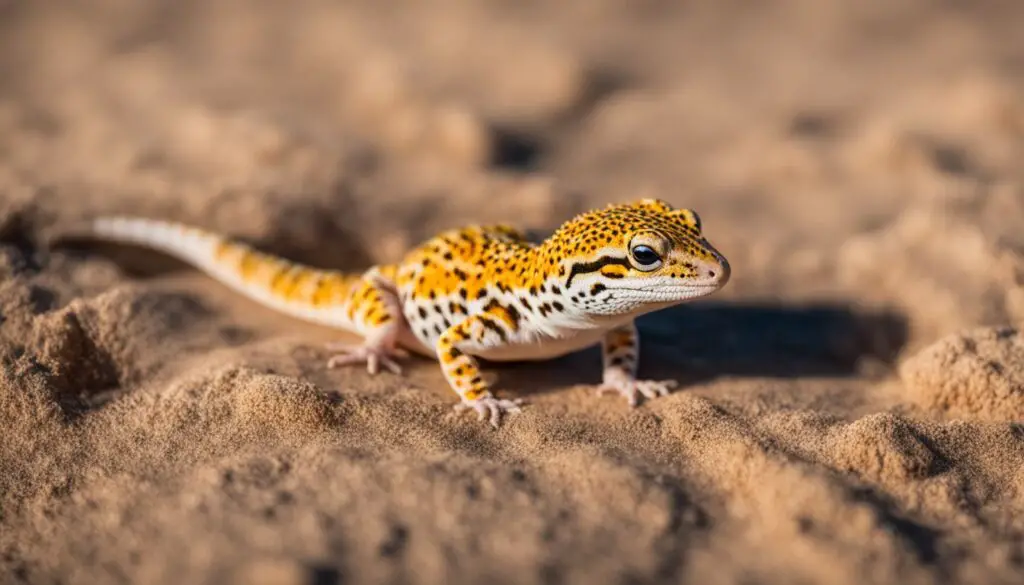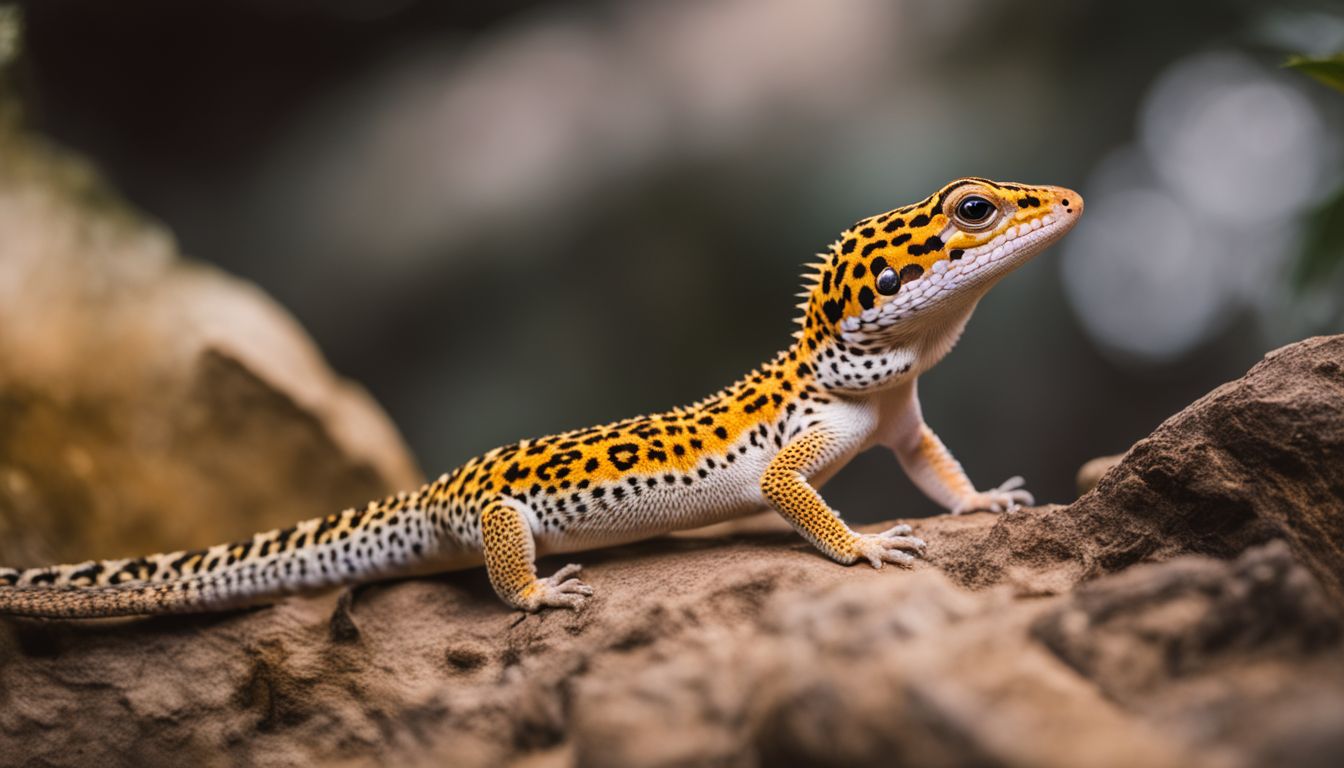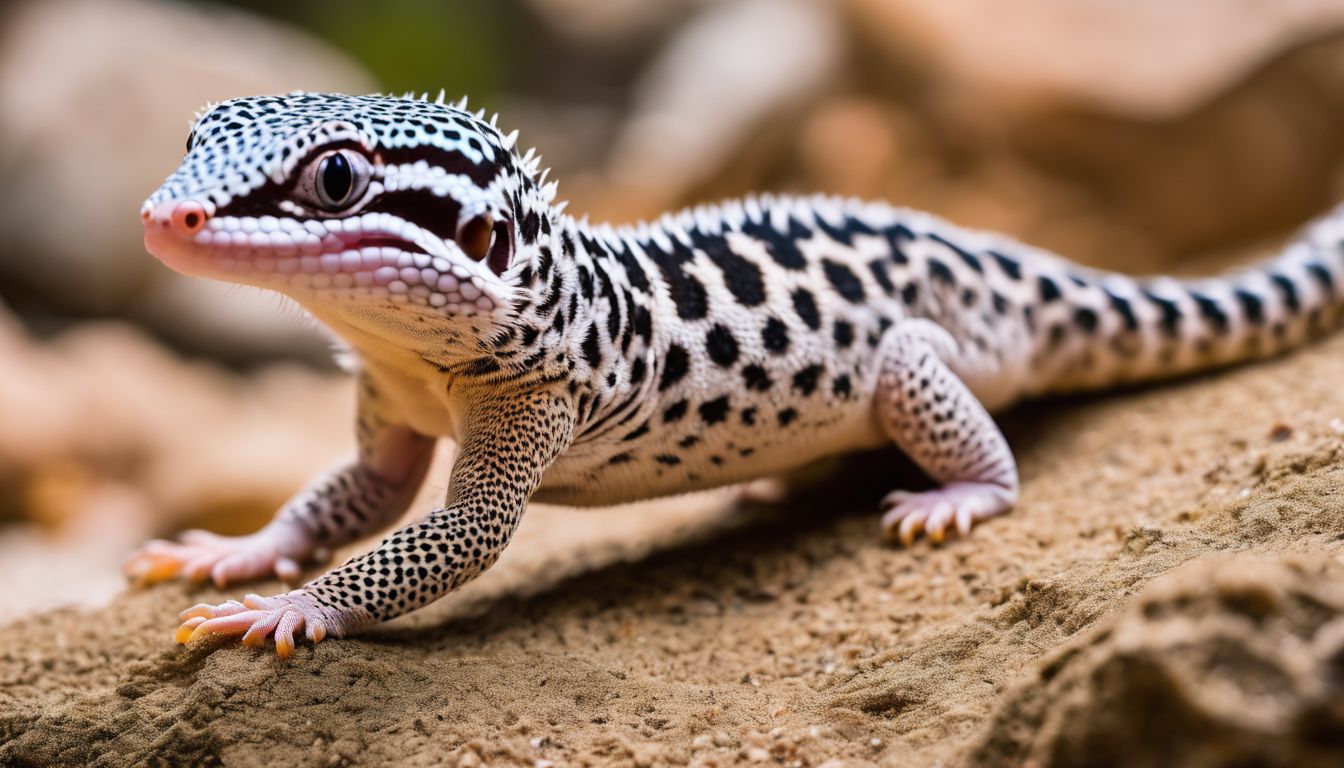Have you noticed your leopard gecko making little pit stops to rub against rocks, decorations, or even the glass of its tank? If you’re puzzling over why your scaly friend is doing the shimmy-shake against everything in sight, you’re not alone.
This behavior can leave many owners scratching their heads, wondering what’s behind these curious actions.
One key fact to remember is that when a leopard gecko starts rubbing itself on different surfaces, it could be trying to shed old skin. Think of it as their version of slipping off an itchy sweater! Our forthcoming article dives deep into this behavior and more – unpacking reasons from shedding help to stress signals and territorial claims.
We’ll guide you through what’s normal and when there might be cause for concern so that caring for your tiny companion will feel like smooth sailing. Ready to become a gecko whisperer? Keep reading; secrets are about to unfold!
Key Takeaways
- Leopard geckos may rub against objects to shed their old skin, mark their territory, or seek relief from discomfort or stress.
- Common reasons for rubbing behaviors include the shedding process and skin irritation, presence of parasites or mites, and territorial marking.
- To address your leopard gecko’s needs, ensure proper humidity levels for easier shedding, check for and treat parasites regularly, provide adequate space and environmental enrichment in their enclosure.
- If your leopard gecko persistently rubs without an obvious cause or displays signs of distress or illness, consult a reptile veterinarian promptly to rule out potential health issues.
Deciphering Leopard Gecko Body Language

Rubbing Against Objects: Marking Territory or Seeking Relief?
Geckos like to claim their space. They rub against things to leave their smell. This tells other geckos, “This place is mine!” But sometimes, they are not just marking territory; they might need help.
If a leopard gecko’s skin feels itchy from shedding, rubbing helps them take off the old skin.
Seeing your gecko rub against its tank often means something’s up. It could be glass surfing because it feels stressed or wants more room. Or maybe it’s trying hard to scratch away mites that bother its skin or has health issues from not enough UV light or calcium.
By watching this behavior and knowing what causes it, you can make sure your pet stays happy and healthy.
Common Reasons for Leopard Geckos Rubbing Against Things

The common reasons for leopard geckos rubbing against things include the shedding process and skin irritation, presence of parasites or mites, and signaling territorial boundaries.
To learn more about what these behaviors mean and how to address your leopard gecko’s needs, keep reading!
Shedding Process and Skin Irritation
Leopard geckos shed their skin as they grow. It’s normal, but sometimes the old skin sticks and irritates them. To help peel off this tight skin, they might rub against rocks or decorations in their home.
They do this to get relief and make sure all the old skin comes off.
If your gecko is rubbing a lot, check for skin that hasn’t come off, especially on toes or tail. Stuck shed can be uncomfortable or even dangerous if left too long. After looking at shedding issues, we should think about other pests like mites that could bother your leopard gecko.
Presence of Parasites or Mites
Besides shedding, another reason a leopard gecko might rub on things is due to tiny pests. These creatures, called parasites or mites, can make your gecko feel itchy and uncomfortable.
Think of how you scratch when a mosquito bites you; it’s like that for your gecko but even more annoying because they can’t use their hands to scratch.
If mites are in the picture, your pet will try to scrape them off by rubbing against objects in their home. It’s important to keep an eye out for these pests; they look like small dark spots on the skin or hiding in the creases.
Quick action is needed if you spot these unwanted guests because they can make your leopard gecko very sick.
Signaling Territorial Boundaries
Leopard geckos rub against objects to mark their territory. It’s a way for them to say, “This is mine!” They do this even if they are the only gecko in the enclosure. So, if you see your leopard gecko rubbing against things, it might be telling other geckos (even if there aren’t any) that the space belongs to it.
Understanding this behavior can help ensure your pet feels secure in its home and less likely to become stressed.
Moving on to “Addressing Your Leopard Gecko’s Needs” – let’s talk about how to make sure your gecko has everything it needs for a healthy and happy life.
Addressing Your Leopard Gecko’s Needs
Ensuring Proper Humidity for Easier Shedding
Checking for and Treating Parasites
Providing Adequate Space and Environmental Enrichment
Ensuring Proper Humidity for Easier Shedding
Maintaining the right humidity level is crucial for your leopard gecko’s shedding process.
- Leopard geckos need a humidity level of 20 – 40% in their enclosure to aid in shedding.
- Keep the terrarium substrate slightly damp to create a humid microclimate, which assists in loosening the gecko’s old skin.
- Using a reptile – safe humidifier or misting the enclosure lightly can help regulate humidity levels.
- Ensure proper ventilation to prevent excessive moisture buildup that can lead to respiratory issues for your gecko.
- Providing a moist hide with sphagnum moss or paper towels allows your gecko to retreat to a more humid environment during shedding.
Checking for and Treating Parasites
To check for parasites in your leopard gecko and ensure their well-being, follow these steps:
- Watch for signs of parasites like abnormal feces, decreased appetite, or weight loss. If you notice these signs, consult a reptile veterinarian.
- A fecal test can detect parasites. Your vet can perform this test to identify any internal parasites that may be affecting your gecko.
- Ensure the enclosure is clean and the substrate is free from potential sources of parasites such as contaminated food or water.
- Quarantine any new leopard geckos before introducing them to your existing ones to prevent the spread of parasites.
- Regularly clean and disinfect your gecko’s habitat using reptile – safe products to minimize the risk of parasitic infestations.
Providing Adequate Space and Environmental Enrichment
After checking for and treating parasites, it’s important to ensure that your leopard gecko has enough space and a stimulating environment in their enclosure. Here are some key considerations for providing adequate space and environmental enrichment:
- Enclosure Size: Leopard geckos need ample space to move around comfortably. A 10-gallon tank is suitable for one gecko, but larger tanks are recommended if you have multiple geckos.
- Substrate Selection: Choose a substrate that allows for natural behaviors like digging and burrowing, such as coconut fiber or paper towels. Avoid loose substrates like sand, which can cause impaction if ingested.
- Hiding Spots: Provide plenty of hiding spots using caves or hollowed logs to create a sense of security for your gecko.
- Climbing Structures: Adding branches or rocks will give your gecko opportunities to climb, promoting physical exercise and mental stimulation.
- Environmental Enrichment: Offer different textures, such as crumpled paper or textured mats, in certain areas of the enclosure to encourage exploration and provide sensory stimulation for your gecko.
- Temperature Gradient: Ensure that the enclosure has a warm side (around 90°F) and a cooler side (around 70-75°F) to allow your gecko to regulate its body temperature effectively.
- Lighting and UVB Exposure: Provide a proper day-night cycle using appropriate lighting, including access to UVB light sources, which are essential for calcium metabolism and overall well-being.
Diet Considerations for Leopard Geckos
Leopard geckos can eat mealworm beetles, but it’s essential to ensure a balanced and nutritious diet for your pet. Providing a variety of feeder insects, such as crickets, dubia roaches, and waxworms, is crucial for their health and well-being.
Can Leopard Geckos Eat Mealworm Beetles??
Leopard geckos can eat mealworm beetles, but it’s important to be cautious because the hard outer shell of the beetle may be challenging for them to digest. Ensure that the beetles are appropriately sized and gut-loaded with nutritious food before feeding them to your gecko.
This will help provide essential nutrients and avoid potential digestive issues for your pet. It’s crucial to monitor their intake and observe any adverse reactions after feeding mealworm beetles.
Understanding what leopard geckos can eat is vital for their health and well-being. Along with mealworms, there are other suitable feeder insects like crickets and dubia roaches that can provide a balanced diet for these reptiles without posing digestive risks.
By offering a varied diet, you can ensure that your leopard gecko receives all the necessary nutrients for their overall health.
When to Be Concerned About Rubbing Behaviors
If your leopard gecko is persistently rubbing against objects with no apparent cause, or if you notice any accompanying signs of distress or illness, it’s important to seek advice from a reptile veterinarian.
Persistent Rubbing with No Apparent Cause
Persistent rubbing in leopard geckos, especially without a clear reason, can signal underlying health or environmental issues. This behavior could indicate skin irritation from dirty or abrasive enclosure surfaces.
Additionally, mites or parasites infestation can cause discomfort, leading to excessive rubbing. It’s crucial to rule out these health concerns to ensure your gecko’s well-being.
In some cases, metabolic bone disease due to inadequate UV lighting and calcium supplementation can lead to persistent rubbing behavior in geckos. Therefore, ensuring proper lighting and nutrition is essential for preventing this issue.
Accompanying Signs of Distress or Illness
If your leopard gecko is displaying unusual behavior like excessive rubbing or glass surfing, it could be a sign of distress or illness. Keep an eye out for defensive postures, decreased appetite, or changes in stool frequency and consistency.
Additionally, if you notice any issues with shedding, such as retained shed on the toes or tail tip, it might indicate health problems that need attention. Understanding these accompanying signs can help you identify any underlying issues early.
Beyond recognizing distress or illness in your leopard gecko, being aware of its body language and behaviors can provide valuable insights into its well-being. Proper husbandry practices and attentive care are crucial for maintaining a healthy and content gecko.
By ensuring a suitable habitat and promptly addressing any concerning signs, you can offer the best possible care to your pet.
Conclusion
In conclusion, understanding why your leopard gecko rubs against things is crucial for providing proper care. By recognizing their behavior and causes, you can address shedding issues, stressors, and territorial marking efficiently.
Implementing practical tips like ensuring proper humidity and addressing parasites will significantly impact your gecko’s well-being. Additional resources from reptile experts or dedicated websites can further enrich your knowledge on leopard gecko behaviors.
Take action today to ensure a healthy and content leopard gecko in your care!
For insights on tailoring your pet’s diet, discover whether leopard geckos can eat mealworm beetles in our latest article.
FAQs
1. Why does my leopard gecko rub against things?
Leopard geckos may rub against things to shed their skin, mark territory, or alleviate stress.
2. What should I do if I notice my leopard gecko rubbing frequently?
If your leopard gecko is rubbing excessively, ensure its habitat has the right humidity for shedding and monitor for signs of stress. If concerns persist, consult a reptile veterinarian.
3. Can rubbing against objects indicate health issues in leopard geckos?
Yes, frequent rubbing can sometimes signal health issues such as skin irritation, parasites, or improper shedding conditions requiring attention from a reptile specialist.
4. How often do leopard geckos usually shed their skin by rubbing?
Leopard geckos typically shed every 4-8 weeks as they grow. Increased activity around shedding periods is normal.
5. What are some ways to create an ideal environment for my leopard gecko to prevent excessive rubbing?
Maintain proper humidity levels in the enclosure and provide appropriate surfaces like rough rocks or logs to aid in natural shedding behaviors and minimize stress-induced friction.




